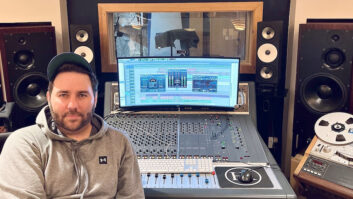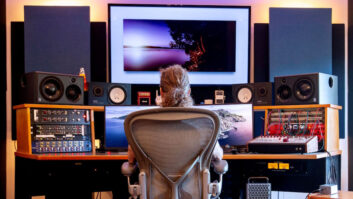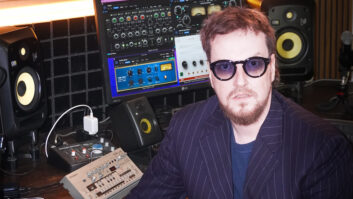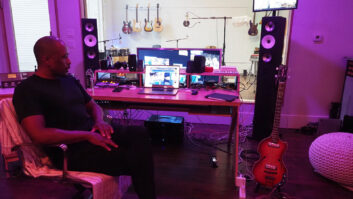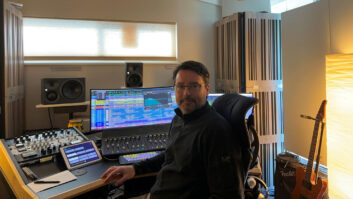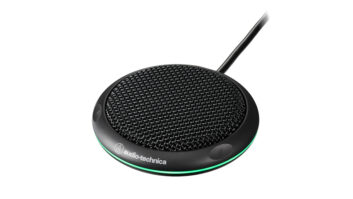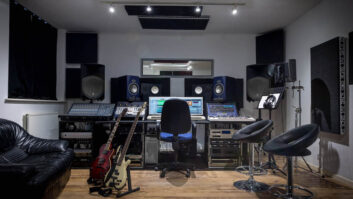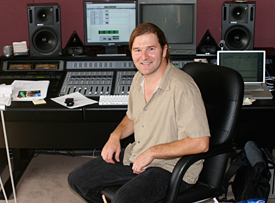
Kennedy Wright of Kennedy Sound in Washington, D.C.
The term sound-for-picture traditionally has been linked to the music and sound that accompanies major motion pictures, but we’ve entered into a new era. Thanks to technology, the Internet, and new marketing methods, sound for picture now relates to multiple types of projects, which offers some much-needed good news for audio post and sound professionals. In this month’s “Confessions” column, we’ll highlight some of the latest opportunities springing up for small to mid-sized studios, review new approaches to more traditional projects, explore some emerging trends, and provide a few tips for success in this promising market.
Opportunities in Unexpected Places
With the increasing use of video in just about every facet of our society, there are new and unique sound-for-picture opportunities for audio post professionals springing up everywhere. You may find yourself experiencing a, “Wow, I didn’t even think of that,” moment after reading about some of the projects in which sound for picture plays a pivotal role. Case in point: museums. They don’t exactly scream sound design, yet opportunities within them are becoming a hot commodity among both sound and audio professionals, as many museums are incorporating high-tech elements and amping up their audio-visual presentations. These presentations, which typically cover films shown in theaters or incorporated within exhibits, often rely on sound design to add impact to their messages. One sound designer who has been able to take advantage of this emerging trend is Kennedy Wright, the owner of Kennedy Sound (Washington, D.C.), a one-man shop that just celebrated its 10th anniversary. Wright’s “sound for museum” work has included projects for the Woodstock Museum, the Museum of Science and Technology in Chicago, and the Museum for the University of North Carolina.
According to Wright, one of the biggest keys to success in this medium is analyzing and fully understanding the floor plan of the space in which sound will be incorporated. “A lot of the time, museum theaters have intricate sound setups that I have to take into account when working on a project, so the very first thing I do is study the floor plan,” says Wright, who often finds himself re-creating the space in his studio. “The audio can be completely wacky because of the physical space, but I’m happy to hang speakers and do what I have to do to re-create comparable surroundings so that I have an idea of what it’s going to sound like in the real space.” When he took on the sound for the Carter Presidential Library’s theater, for instance, he was required to mix in 6.0 and figure out a way to create an environment in which sound panned six panels across the front of the theater. “I didn’t have a template, so I set up six speakers across my console and mixed from there,” he says. “The sound design and editing of these projects usually takes quite a bit longer than other projects, but it’s really enjoyable,” adds Wright, who relies on Pro Tools 8 and typically the plug-in Unwrap for his museum sound work.
The team at Edge Studio in New York City
Museums are one thing, but what about your dentist’s office? Not getting the connection yet? Well, maybe you’ve noticed the addition of a TV and DVD player in the waiting room of your dentist or doctor’s office. That’s because many professionals, in the medical community and beyond, have begun to play sales and promotional videos in waiting areas that combine product promotion with educational content. Each of these customer-centered videos relies on sound support—in some cases, quite heavily. For example, New York City’s Edge Studio recently provided voice recording and sound support for a series of waiting-room videos produced for TIAA CREF that provides information on financial investments. “The video communicates to TIAA CREF’s customers that their local office offers numerous services, and it explains the processes, the benefits, the risks, of such services, so it’s part education and part sales,” says Edge Founder and President David Goldberg. Each of these videos features sound elements, most often in the way of voice-overs.
In fact, the voice-over plays such a critical role in today’s sound-for-picture projects that Edge has built a successful business on it. The company, which has grown to a staff of 22, specializes in providing voice recording and sound design for an extensive range of projects that include everything from animated educational videos for Disney to corporate sales presentations for Royal Caribbean Cruise Lines to training videos for the U.S. Army, and everything in between. And they’re not alone. While EggHead Productions in Rocklin, Calif., bills itself as a video production facility that focuses on branded entertainment, much of the company’s work—which centers on small to mid-tier businesses, government productions and creative content-driven projects such as Webisodes—is voice-over–heavy, reports Creative Director Dan Cunningham.
When it comes to voice-overs, a new trend has begun to take over. Foreign language recording, or ESL (English as a second language), has become big business for audio post facilities. “These projects require another set of skills on top of the ones needed to capture a solid voice recording, as translation is obviously a factor,” explains Goldberg. “For instance, we work on a number of projects that require English-to-Spanish translation. The challenge in these projects lies not only in the fact that there are multiple dialects in Spanish, but also in that Spanish is spoken at a different rate from English. If we’re doing a 60-second spot, for instance, it would typically run 75 seconds when done in Spanish, so we’ve got to be able to edit and effectively limit word choices to meet time requirements,” says Goldberg, who says Edge has created partnerships with a number of language and dialect experts to ensure accuracy.
Additional types of projects that require audio post work that are lesser known, yet popular, include “360s,” or Web-based tours (which are prominently used in the real estate, home rental, and health club industries); tutorials and Webinars; trade show videos; and branding videos.
Traditional Work Still Available
Even with the wave of new technology available, the more traditional sound-for-picture projects haven’t vanished and aren’t expected to disappear anytime soon, yet the
work that sound designers are called upon to complete has undergone some changes. Documentary films, for instance, make up a big chunk of Wright’s workload. In most cases, much of his time on these projects is spent repairing audio. “A lot of documentary work is really run and gun
and the camera operator is concentrating on getting the shot, rather than the sound,” says Wright. “More often than not, there’s no boom operator, no cable guy, no sound mixer. While the cinematographer may get a great shot, he or she will seldom get great sound.” For Wright, that typically results in a lot of clean up, sound replacement, Foley work, and custom environmental sound creation, which he captures with his Sony handheld recorder. A good example is Wright’s work on Kicking It, a documentary that chronicles the journey of the International Homeless
World Cup of Soccer. According to Wright, production sound was “a mess,” and, as a result, he spent a majority of his time in clean-up mode. “Because the film was shot throughout the world, the producers had to use pick-up crews, so there were multiple sound sources,” explains Wright, who was left to contend with finding a way to bring
consistency to sound, which was captured by an array of camera mics, lavaliers and booms, as well as varying formats. In Spain, for instance, crews recorded in MS. The format inconsistency had to be accommodated, and Wright had to re-create most of the sounds in the film, including sneaker squeaks, body checks, cheers, groans, boos, and
referee whistles, because what had been captured in the field simply wasn’t usable. “The biggest challenge for me was taking all of the variables, smoothing them out and creating a coherent mix,” says Wright.
Dan Cunningham of EggHead Productions in Rocklin, Calif.
On the other hand, Cunningham—who admits that he is not an audio engineer, but rather a video producer who happens to be familiar with the recording process and sound design fundamentals because of his experience as a musician—typically uses SoundSoap Pro for repairing audio field problems. In addition, he uses features offered through
Final Cut Pro Suite to create sound effects. That’s what he used for a children’s educational program called An Afternoon With Music Matt, for which he created sound design. “I had to incorporate a laugh track into the project, but I couldn’t find any tracks that featured
children,” Cunningham says. “I was able to use Final Cut Pro to pitch up the adult laugh track I had so that it sounded like a room full of kids.” Educational projects like this one are perfect fodder for audio post professionals, as they generally require the incorporation of sound effects and music, and today, the Internet provides even more opportunities for distribution. An Afternoon with Music Matt, for instance, is Web-based and will be pitched to schools as a part of series of music education programs that can be downloaded and shown in
the classroom.
Music production and supervision are main ingredients in many of the
projects landing in the hands of small and mid-sized studio owners.
Wright reports that his primary responsibilities for his work on
political spots include creating custom music and choosing appropriate
music. “While political consultants can, and sometimes do, work
directly with music libraries and choose their own music for spots,
it’s a black art that they generally prefer to have other people do
most of the time,” he explains Wright, who says he works both with
local composers and standard music libraries.
Dominating Trends
While opportunities are plentiful and the
scenario is actually pretty rosy for engineers who consider themselves
well versed in the sound-for-picture arena, there are still some
realities that can’t be discounted. One is the fact that, thanks to the
ever-increasing availability of technology, many companies and agencies
have begun taking on sound design in-house. “Years ago, much of the
documentary work around the Washington, D.C., area was generated by
National Geographic and Discovery, but that work has pretty much
vanished because both have huge facilities in which they can do a lot
of the work in-house,” says Wright. And to add insult to injury, “If
they’re not doing it in-house, they’re working with larger production
facilities—not the little guys.”
On top of that, corporate videos used for internal purposes are
beginning to dry up because of shrinking budgets. Many companies simply
no longer have the budgets to justify such projects, which, at one
time, were the lifeblood for many sound designers and video producers.
In the case of sound for picture, however, it seems the prospects
outweigh the challenges, which is certainly welcome news for sound
professionals. The sheer volume of opportunities, in fact, has
presented Goldberg with a problem that most of us can only dream of
having: “We have so much work right now,” he says, “that we’re
converting an AC closet into another studio because our workload
demands more employees than we can fit into our current office setup.”
Studio Unknown is full-service audio post-production facility and
recording studio that specializes in helping clients discover creative
sound for film, video, Web, gaming, and artist projects. For more
information, visit www.studiounknown.com.
Tips for Sound-for-Picture Success
Do your homework. If you’re an audio engineer who has worked
primarily on music projects, don’t assume that you can instantly make
the leap to a sound-for-picture project without doing some serious
homework. “Recording a rock band is not the same as recording a
voice-over artist,” says Goldberg, who started out as a music producer
before making the transition to audio post. “If you study commercials,
you’ll realize that there are no breaths or mouth clicks, the music is
supporting the voice, and the low end on the vocals has been decreased,
which is different from recording a band.”
Assess where you are, and be realistic about your goals. “Don’t
shoot for the stars if you don’t have a ladder,” cautions Goldberg. He
suggests that if you don’t currently have any contacts in the
advertising or visual media worlds, then you shouldn’t expect to land a
major advertising campaign out of the gate. Instead, start small and
work yourself up to the bigger projects. If you live in small
community, for instance, you could go to your local florist, bank, or
grocery store, for example, to offer services for a small fee.
Know your audience. “It’s critical that you know who you’re
talking to, why you’re talking to them, and where they are listening to
you,” says Goldberg. Without these important pieces of information, it
will be nearly impossible to deliver sound for picture projects in an
effective manner.
Be inventive. Don’t overlook opportunities that lie in new media
trends. “Though viral video is, in theory, supposed to spontaneously
catch fire, many agencies are designing media for the purpose of
becoming viral and are, in turn, willing to sink thousands of dollars
into producing quirky videos,” says Wright. Even though sound design
may be a secondary consideration in some cases, there may be hidden
opportunities that lie within these types of projects, but it’s up to
sound professionals to seek them out and figure out a way to convince
potential clients of the ways sound design could benefit their project.
Limit your limitations. In other words, find a way to make it
happen. “We’ve had clients ask for delivery of a project in a format we
know nothing about—and sometimes have never even heard of—so we have to
think on our feet,” says Goldberg. “We tell them, ‘Yes. Absolutely, we
can deliver your project in that format,’ and then we quickly do
research and figure out just how we can make it happen for them.”
Team up. Don’t expect to have all of the answers or
capabilities. If you’re given the opportunity to work on a project that
involves a foreign language that you’re not familiar with, identify and
team up with a reliable resource that can take on that portion of the
project for you. “For a recent government project that required us to
produce a piece in 12 different languages, we teamed up with a language
specialist,” says Cunningham. While you can’t expect to know how to do
everything, you can partner with those who know how to do what you
don’t.
